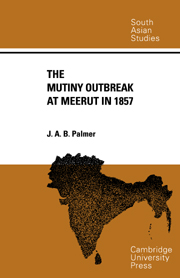Book contents
- Frontmatter
- Contents
- Introduction
- 1 CHAPĀTĪS
- 2 GREASED CARTRIDGES
- 3 THE PRESIDENCY DIVISION, FEBRUARY TO MAY
- 4 REGIMENTS AND OFFICERS AT MEERUT
- 5 MEERUT CANTONMENT IN 1857
- 6 THE FIRING PARADE OF 24 APRIL AND ITS SEQUEL
- 7 THE OUTBREAK: (a) The Native Infantry Lines
- 8 THE OUTBREAK: (b) The Native Cavalry Lines
- 9 THE OUTBREAK: (c) The Bazar Mobs
- 10 THE OUTBREAK: (d) The European Troop Movements and the European Lines
- 11 THE HANDLING OF THE EUROPEAN TROOPS
- 12 TO DELHI
- 13 CONCLUSIONS
- Notes and References
- Index
- Plan of Meerut Cantonment in 1857
4 - REGIMENTS AND OFFICERS AT MEERUT
Published online by Cambridge University Press: 24 October 2009
- Frontmatter
- Contents
- Introduction
- 1 CHAPĀTĪS
- 2 GREASED CARTRIDGES
- 3 THE PRESIDENCY DIVISION, FEBRUARY TO MAY
- 4 REGIMENTS AND OFFICERS AT MEERUT
- 5 MEERUT CANTONMENT IN 1857
- 6 THE FIRING PARADE OF 24 APRIL AND ITS SEQUEL
- 7 THE OUTBREAK: (a) The Native Infantry Lines
- 8 THE OUTBREAK: (b) The Native Cavalry Lines
- 9 THE OUTBREAK: (c) The Bazar Mobs
- 10 THE OUTBREAK: (d) The European Troop Movements and the European Lines
- 11 THE HANDLING OF THE EUROPEAN TROOPS
- 12 TO DELHI
- 13 CONCLUSIONS
- Notes and References
- Index
- Plan of Meerut Cantonment in 1857
Summary
The complement of foot and mounted troops at Meerut early in 1857 was a regiment of British infantry, a regiment of British cavalry, two regiments of native infantry and one regiment of native light cavalry. The station had recently become the headquarters of the Bengal Artillery, and of this arm there were in station a troop of horse artillery with six guns, a company of foot artillery, a light field battery with six guns, and a number of recruits. The Bengal Artillery was manned by European gunners and Indian ranks known as golandāz. This complement of troops was hardly ever complete during the period from 1 January to 1 May 1857.
The European infantry regiment present throughout these months was the 1st Battalion of the 60th Q.R.R. which had arrived on 31 December 1855 with a strength at that date of 18 officers and 814 other ranks. It suffered quite nastily from the cholera in August 1856, losing 29 men. An observer on 10 May, O'Callaghan, gives its strength on that date as 901 officers and other ranks: it had presumably received a draft or drafts since the end of 1855.
There was no British cavalry regiment until II March, on which date there arrived the 6th Dragoon Guards (the Carabiniers). They had been brought home from the Crimea unhorsed in May 1856, had taken a draft in England of 408 recruits, and had sailed for India with a strength of 33 officers and 704 other ranks.
- Type
- Chapter
- Information
- The Mutiny Outbreak at Meerut in 1857 , pp. 34 - 46Publisher: Cambridge University PressPrint publication year: 1966



